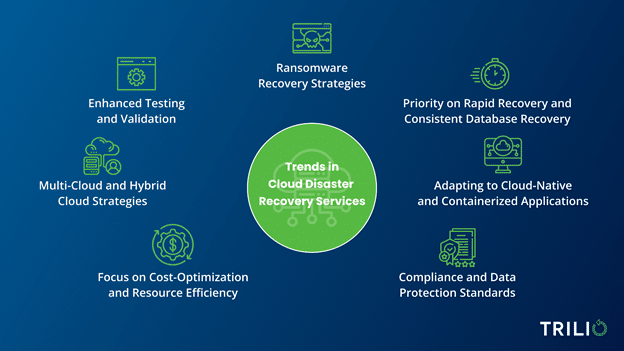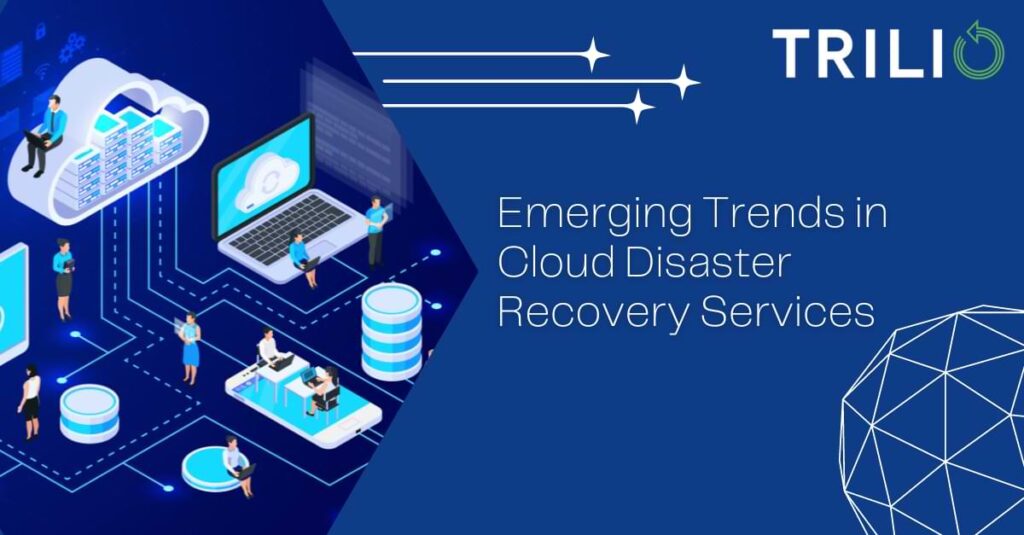Recent studies highlight the importance of cloud disaster recovery services for modern-day businesses. According to McKinsey, organizations are eager to get their share of a $3 trillion opportunity enabled by using cloud platforms, with a significant portion depending on resilient cloud applications. The move to the cloud promises enhanced stability, flexibility, and sophisticated resiliency tools, but it requires choosing appropriate strategies that meet both business requirements and customer expectations. However, there’s caution in the air; less than 10% of large organizations have moved their mission-critical processes to the cloud, partly due to rising customer expectations and evolving regulations.
The 2023 TechTarget’s Computer Weekly IT Priorities Survey indicates a strong focus on disaster recovery, with 37% of respondents prioritizing it for data protection. Additionally, 34% are investing in hybrid cloud infrastructure to manage growing data complexity, and 45% are concentrating on cloud infrastructure and operations. This article explores seven key trends in cloud disaster recovery services, highlighting the role of solutions like Trilio in addressing these evolving priorities.
Top 7 Trends in Cloud Disaster Recovery Services

1. Adapting to Cloud-Native and Containerized Applications
The increasing adoption of cloud-native and containerized applications is reshaping disaster recovery strategies. Traditional methods struggle with the dynamic nature of these modern apps, leading to longer downtimes and complex restoration processes. This shift is driving the development of specialized solutions, a market projected to reach $13.7 billion by 2027. This trend is prompting the development of specialized disaster recovery solutions that are attuned to cloud-native environments. Leveraging containerization technologies and orchestration platforms, these innovative solutions offer rapid application recovery, the ability to roll back deployments, and the flexibility to scale seamlessly during disaster situations. Moreover, the integration of orchestration and automation within these platforms is crucial, ensuring efficient management and operation of disaster recovery processes. This alignment with automation and orchestration not only enhances the resilience of cloud-native applications but also ensures that disaster recovery tools are capable of maintaining critical operational efficiencies in crisis scenarios. This evolution in disaster recovery approaches ensures alignment with the latest application technologies and infrastructures.
2. Priority on Rapid Recovery and Consistent Database Recovery
Quick recovery of data and systems is essential for businesses, particularly in disaster scenarios. There’s a growing emphasis on strategies that enable faster recovery times, which involves leveraging advanced backup and storage solutions, along with ensuring robust network infrastructure to support rapid data transfer and restoration. This trend comes with a focus on consistent database recovery, a critical component given the key role of databases in business operations. The integration of software for managing and executing rapid restoration processes, along with deploying advanced storage solutions, is driving innovation in backup and disaster recovery services. These advancements aim to minimize business operation disruptions and significantly reduce recovery time.
Learn about the features that power Intelligent backup and recovery
3. Multi-Cloud and Hybrid Cloud Strategies
The shift towards multi-cloud and hybrid cloud strategies is a response to the need for more resilient and flexible disaster recovery solutions. By utilizing a combination of different cloud services and providers, organizations can avoid vendor lock-in and benefit from the unique strengths of each platform. This approach allows for more tailored disaster recovery strategies that can be adapted to specific organizational needs. Additionally, hybrid cloud environments offer the best of both worlds, combining the security and control of private clouds with the scalability and cost-effectiveness of public clouds. This flexibility is crucial in ensuring that disaster recovery plans are both efficient and effective.
4. Ransomware Recovery Strategies
With the rise in ransomware attacks, the focus has shifted towards developing robust recovery strategies specifically designed to counter this threat. This involves not only implementing strong security measures but also advanced strategies like regular backups and employee education on cybersecurity. The aim is to create a resilient infrastructure that can provide ransomware protection and quickly recover from attacks.
5. Enhanced Testing and Validation
The increasing complexity and volume of data call for a more thorough approach to testing disaster recovery plans. As the intricacy of data and systems increases, the presence of a solid testing process is crucial. Consistent testing serves two key purposes: it confirms that disaster recovery strategies work effectively and identifies areas that need refinement. By adopting this proactive stance, organizations can consistently prepare for potential disasters, thereby reducing the risks of extensive downtime or data loss.
6. Compliance and Data Protection Standards
In a global business environment, compliance with standards like DORA and GDPR has become a crucial aspect of disaster recovery planning. This trend involves a comprehensive approach to data management, encompassing protection, storage, backup, security, and destruction. Ensuring compliance with these standards is not just a legal necessity but also a key component of maintaining customer trust and business reputation. As such, disaster recovery plans are increasingly being designed with these compliance requirements in mind, ensuring that all aspects of data management are covered.
7. Focus on Cost-Optimization and Resource Efficiency
Businesses today are demanding solutions that not only guarantee data protection but also prioritize cost-effectiveness. This trend manifests in several ways:
- Lean Infrastructure and Resource Sharing: Providers are optimizing disaster recovery infrastructure through technologies like deduplication, compression, and tiered storage. This minimizes data footprint and optimizes storage costs, preventing businesses from paying for duplicate or irrelevant data. Resource sharing across multiple clients also improves efficiency and cost benefits.
- Pay-as-you-go Models: Gone are the days of hefty upfront investments. These models are on the rise, allowing businesses to pay only for the resources they use.
- Automated Resource Management: Advanced disaster recovery solutions embrace automation to streamline resource allocation and utilization. This includes features like dynamic scaling, workload balancing, and automatic failover, ensuring resources are used efficiently during recovery scenarios, further reducing unnecessary costs.
Perform secure central application centric backup container, vms, helm & Operator
Used Pre-Stage snapshots to instantly test, transform and restore during recovery
Scale with fully automated policy-driven backup and recovery worklow
Trilio's Role in Disaster Recovery Innovation
Cloud disaster recovery services are rapidly evolving, with these seven trends playing a key role. Trilio, with its advanced technology and expertise, is at the forefront of this evolution. By offering solutions that cater to the need for speed, flexibility, security, and compliance, Trilio is the ideal partner for businesses looking to future-proof their disaster recovery strategies.




